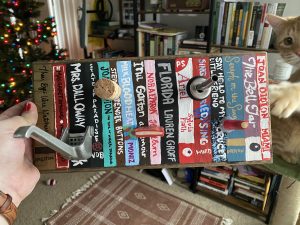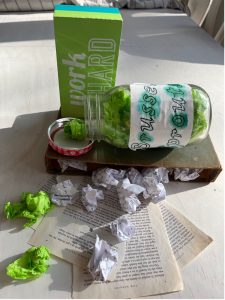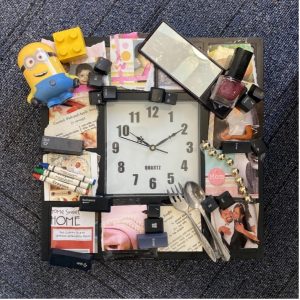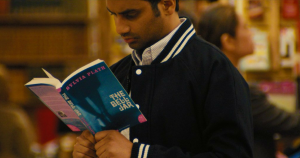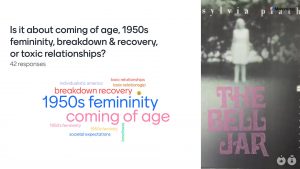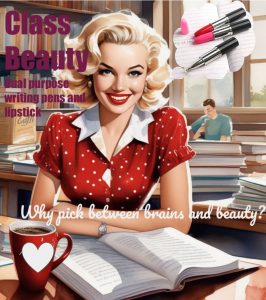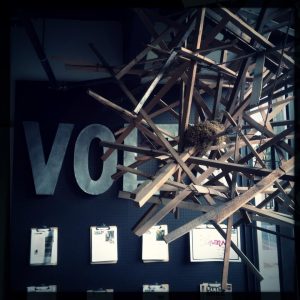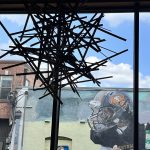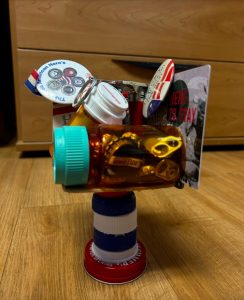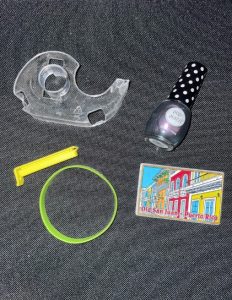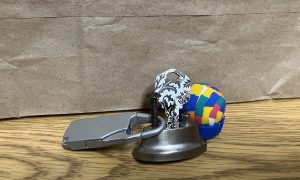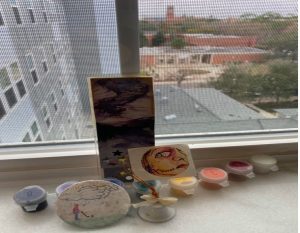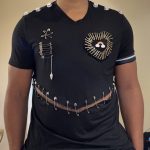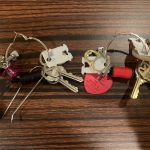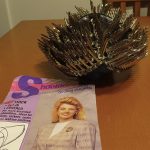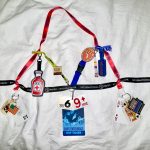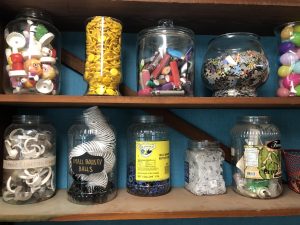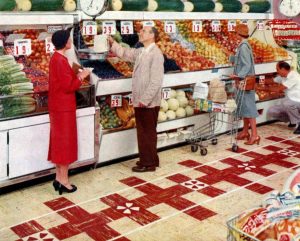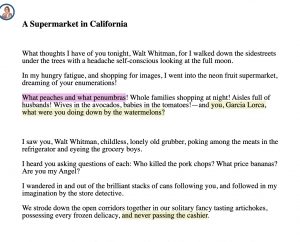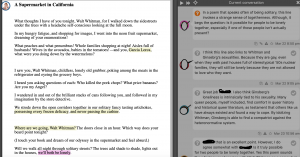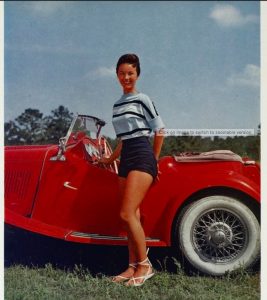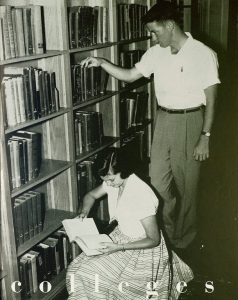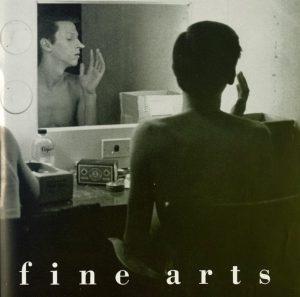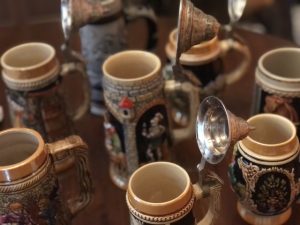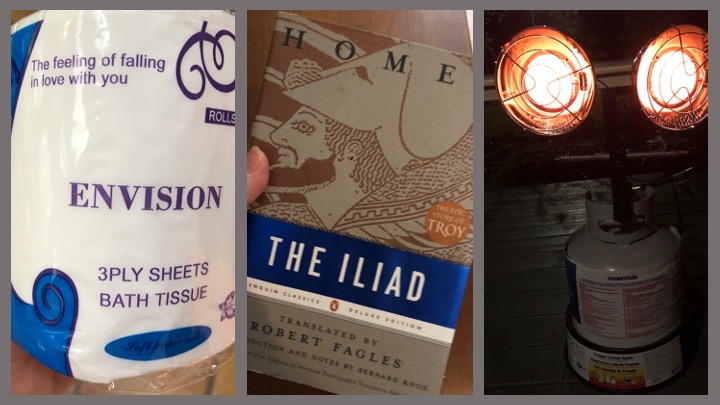 I’m always surprised when I find it again, tucked in the corner of a little-used bookshelf in the house: the first children’s picture book I remember, Miss Suzy (1964). When l was a wee preschooler, my mother read to me this book about a tiny housekeeper–a little gray squirrel who lived all by herself in the tip, tip, top of a tall oak tree. Miss Suzy relishes two of the three C’s that marked the idealized Fifties housewife: cooking and cleaning. But not childrearing. She sang as she performed her domestic routine. How I loved the pictures in this book! The muted, tranquil images of Miss Suzy at work in her house. The vivid facial expressions of satisfaction, malice, dismay, and determination. The nighttime view of the open treehouse in the sky, which first appears in vibrant colors.
I’m always surprised when I find it again, tucked in the corner of a little-used bookshelf in the house: the first children’s picture book I remember, Miss Suzy (1964). When l was a wee preschooler, my mother read to me this book about a tiny housekeeper–a little gray squirrel who lived all by herself in the tip, tip, top of a tall oak tree. Miss Suzy relishes two of the three C’s that marked the idealized Fifties housewife: cooking and cleaning. But not childrearing. She sang as she performed her domestic routine. How I loved the pictures in this book! The muted, tranquil images of Miss Suzy at work in her house. The vivid facial expressions of satisfaction, malice, dismay, and determination. The nighttime view of the open treehouse in the sky, which first appears in vibrant colors.
Miss Suzy was resourceful in tending to her house, making her carpet from moss and  her broom from twigs. She made cups and pudding from acorns, and caught fireflies to illuminate her lamps. She wore an apron. My mother, a homemaker and creative soul, read this story to me often–likely learning about this book from her Parents magazine subscription. Like much of the first children’s literature we remember, I suppose, the plot was straightforward and incongruous at once: a sudden invasion of red squirrels disturbs the domestic tranquility, running Miss Suzy out of her beloved home and eating her whole winter’s supply of nuts. Left alone and unhoused on a rainy night, Miss Suzy drops into the attic of an abandoned house and finds a fancy old doll house. She cleans its dust and cobwebs before falling asleep in a four-poster bed. And wouldn’t you know that she finds a box of toy
her broom from twigs. She made cups and pudding from acorns, and caught fireflies to illuminate her lamps. She wore an apron. My mother, a homemaker and creative soul, read this story to me often–likely learning about this book from her Parents magazine subscription. Like much of the first children’s literature we remember, I suppose, the plot was straightforward and incongruous at once: a sudden invasion of red squirrels disturbs the domestic tranquility, running Miss Suzy out of her beloved home and eating her whole winter’s supply of nuts. Left alone and unhoused on a rainy night, Miss Suzy drops into the attic of an abandoned house and finds a fancy old doll house. She cleans its dust and cobwebs before falling asleep in a four-poster bed. And wouldn’t you know that she finds a box of toy  soldiers and awakens them, inviting the merry band to move into her unaccustomedly large and luxurious new home–where she took care of them like a mother. One night she tells the tearful tale of her lost home, and the soldiers decide to repay her kindness by reclaiming her treetop abode from its usurpers. She restores its peaceful and orderly domesticity, falling asleep in her own bed from which she could see a million stars. I’m sure that in my childhood, I’d fall asleep not long after Miss Suzy did.
soldiers and awakens them, inviting the merry band to move into her unaccustomedly large and luxurious new home–where she took care of them like a mother. One night she tells the tearful tale of her lost home, and the soldiers decide to repay her kindness by reclaiming her treetop abode from its usurpers. She restores its peaceful and orderly domesticity, falling asleep in her own bed from which she could see a million stars. I’m sure that in my childhood, I’d fall asleep not long after Miss Suzy did.
I don’t remember if I took this book with me when I moved away from home, or if I found it in my parents’ attic when I was clearing out their house years later. Either way, Mom would have saved it for me. When I first revisited this first book as an adult, I was taken aback by what seemed to be a clear endorsement of 1950s housewifery–and the belief that a woman’s proper place was in the home. Miss Suzy’s trajectory starts and ends with her love of tending house, so of course Parents magazine published this book and advertised it to young mothers in the early 1960s.
 Recently, I retrieved the book from the neglected shelf corner again and turned its pages. In this second take I notice outlier elements that complicate my previous impression. Miss Suzy enjoys keeping this house of her own because she is its sole occupant. She mothers an alternative family of toy soldiers on a temporary basis, yet they are happy to march off on their own in the end–just as she delights in her own company. I now see Miss Suzy’s housework as a series creative acts as well as a domestic routine (those acorn cups!). That is surely why she sings. Miss Suzy seems to be caretaking herself as much tending to the house. How did she come to occupy the tip, tip, top of her oak tree? And why does this book preoccupy me now? Soon I’ll return my childhood book to its new abode, and I’m not sure when I’ll retrieve it again. But when I do I will turn the pages slowly. And I’ll remember. Good night, and sleep well. – MB
Recently, I retrieved the book from the neglected shelf corner again and turned its pages. In this second take I notice outlier elements that complicate my previous impression. Miss Suzy enjoys keeping this house of her own because she is its sole occupant. She mothers an alternative family of toy soldiers on a temporary basis, yet they are happy to march off on their own in the end–just as she delights in her own company. I now see Miss Suzy’s housework as a series creative acts as well as a domestic routine (those acorn cups!). That is surely why she sings. Miss Suzy seems to be caretaking herself as much tending to the house. How did she come to occupy the tip, tip, top of her oak tree? And why does this book preoccupy me now? Soon I’ll return my childhood book to its new abode, and I’m not sure when I’ll retrieve it again. But when I do I will turn the pages slowly. And I’ll remember. Good night, and sleep well. – MB

